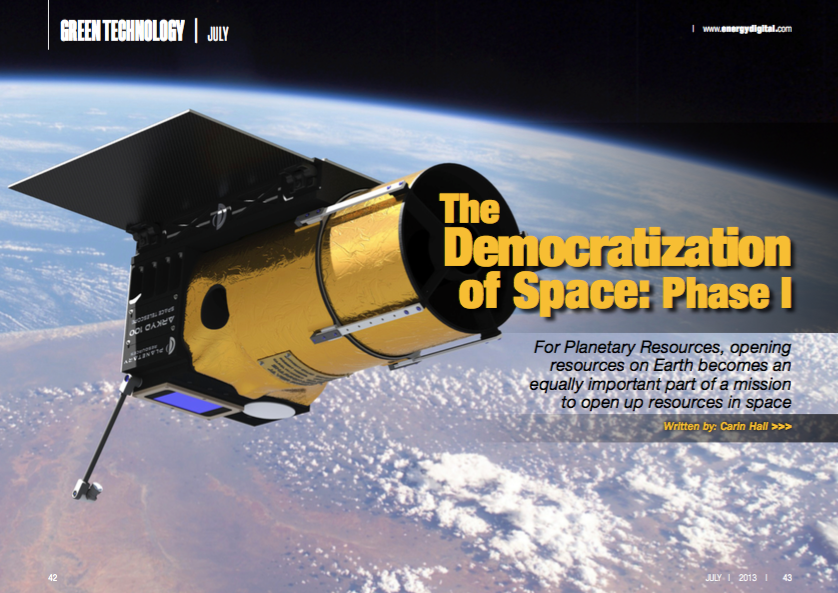The Democratization of Space: Phase I
- Carin Hall
- Jul 13, 2013
- 4 min read

An interview with President and Chief Engineer of Planetary Resources, Chris Lewicki
Shortly after Planetary Resources announced its epic plans to identify and mine asteroids for precious resources,
an unprecedented amount of public support and interest begged for something more—something that would allow the public to take part in the journey in a way that has never been done before.
“The reason we’re here today is the reaction of the crowd,” Co- Founder and Co-Chairman Peter Diamandis says in a recent press conference. “When we announced the company last year, we were blown away by the level of interest and excitement—we’re not ready for it.”
Some 3,500 job applications poured in, while thousands of others inquired about investing and volunteering, anything to get involved. In an effort to respond to an overwhelming level of public support, the team launched a ‘Kickstarter’ campaign through the month of June to crowdfund a space telescope for public use, whether it be for research, personal interest or photographic desires. Compared to the Hubble space telescope, the ARKYD is nearly one hundredth the size and a fraction of the cost, enabling Planetary Resources to make the technology available to the public.
“Within just the first couple of days, we were able to get most of the way towards our campaign goal of a minimum of one million dollars,” President and Chief Engineer Chris Lewicki says in an interview with Energy Digital.
For a pledge of anywhere from $10 to $10,000, donors are given a chance to take “space selfies,” a picture of an uploaded image on the space telescope with the Earth in the background. Higher donations will buy researchers and schools access to telescope time for their own personal research or the option to sponsor a school.
“Establishing a future economy in space has always been very important to us,” says Lewicki. “We wanted to find ways to engage a broader community, more than just the people who work for the company or people who are even in the space industry for that matter. The broad trail of public support for our Kickstarter campaign has really demonstrated to us that this is a worthwhile thing for us to invest time in, identify ways that the community can participate in our mission and, in some ways, even help shape the things that we’ll do as we are exploring the asteroids and developing new economies in space.”
It’s an experiment between engineering, space technology and business practices. Suddenly, engaging the public and education has become just as important as opening up resources in space.
“Our ultimate goal is to expand the economic sphere of humanity off the planet and into the solar system, and to make the exploration and development of space a sustainable activity by creating more economic reasons for doing it, so it’s not depending on funding from government,” says Lewicki.
CULTURAL CHANGE
Considering the fact that space has been widely non-participatory over the last 50 years, bringing people into the equation could drastically reshape future involvement.
“We have the potential to change the course of research and exploration,” says Diamandis, explaining that although the telescope won’t be as advanced as the recently expired Kepler telescope, the important thing is that “this is the beginning of private exploration, the ability for citizen science. Imagine a future in which you don’t have to wait for the government or Congress to decide whether or not this part of the budget should be supporting it or not.”
“We are putting a webcam on Christopher Columbus as he explored the New World,” Co- Founder and Co-Chairman Eric Anderson explains in a press conference. “You are literally going to have the chance to see, feel and listen to what it’s like to explore the solar system. This is a journey that we want you to come along with us, and we want to make that as available as we possibly can to as many people as we possibly can.”
Of course, stimulating a cultural movement with a renewed interest in space is also a strategic move for the company itself.
“If you’re dependent on innovation from within your company, you’re dead,” says Diamandis. “In the future, we’re going to be looking at this crowd to help us do data analysis of asteroids, to develop software and even hardware,” he says. “Our goal is to democratize the access to space, because this stuff has been, for decades, militarized and very expensive.”
COMMERCIALIZATION
Having been exceedingly successful in raising private support, Planetary Resources is well on track to achieving its long-term goals, expecting to extract and return resources from an asteroid to a field depot by the 2020s.
“But more importantly, we actually see opportunities between today and that point in the future, because we are innovating in spacecraft technology and deep- space exploration,” says Lewicki. “These capabilities are important not only to our other governments, but also to businesses and more private applicants.”
“We’re creating solutions and business opportunities to problems that are right here on Earth,” he concludes. “It’s really a perfect time to be faced with audacious challenges [on Earth], because it’s forcing us to set goals and achieve them, and then set more. It’s allowing us to turn science fiction into science fact.”

























Comments